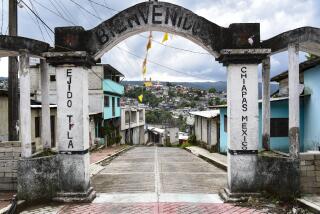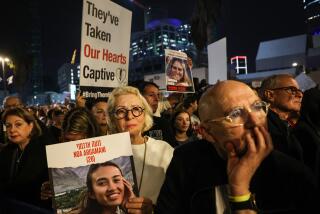Out of Peru’s darkness
TEN YEARS AGO, on April 22, 1997, Peruvian commandos rescued 72 men being held hostage by terrorists in the Japanese ambassador’s residence in Lima. I was one of those hostages.
We had been captives for 126 days. The conditions pushed us to the brink of mental and physical collapse. The terrorists -- there were 14 of them -- seldom let us sleep, putting us through unceasing drills to perfect how they would kill us if security forces attacked. When we did sleep, we were awakened by the cold feet of rats scampering across our faces.
The first few weeks, there were close to 400 hostages, all captured during a party at the ambassador’s house. Conditions then were especially abysmal. Food was scarce; the government shut off electricity and water; toilets backed up and the overwhelming stench permeated the elegant mansion modeled on Tara of “Gone With the Wind.” The irony was lost on us in our misery.
The terrorists from the Tupac Amaru Revolutionary Movement demanded that Peru’s president, Alberto Fujimori, release 400 of their imprisoned comrades in exchange for our freedom. Fujimori refused. Negotiations began, and most of the hostages were released in the first two weeks. But the talks faltered and then collapsed. Mediators struggled to reach a peaceful solution, but the Tupac Amaru leaders would always balk. The 72 of us left did not know from one day to the next if we would live or die. The terrorists shared this uncertainty and became increasingly brutal -- except for the younger terrorists, some of whom were mere teenagers.
These armed adolescents looked over us during long days and sleepless nights locked in the upstairs bedrooms, or as we played board games on a landing at the top of the staircase. We ate Red Cross meals together. To exercise, we paced the hallway, and the guards came with us. There was little to do but talk to one another and to the guards.
I was shocked at how marginalized these young men and women were from society. They knew little if anything of the world beyond their impoverished jungle and mountain villages. For them, violence seemed the only realistic path to change.
As time passed, these youngsters railed against their leaders, whom they accused of misleading them into believing the siege would be over in a matter of days or weeks rather than months. The leaders punished them with slaps, punches and rifle-butt strokes to tender parts of the body. Meanwhile, the other hostages and I gathered intelligence and sent it to the outside by way of transmitters planted in Bibles and inside my guitar.
At one point, it appeared Fujimori might offer the terrorists free passage to Cuba if they released us. A guard, a teenage girl, approached me with an AKM rifle dangling from her slender shoulder. The barrel almost touched the floor. The girl shyly asked: “Senor, could you please tell me how long it takes a bus to go from Lima to Cuba?” Several hostages who overheard the question laughed. I did not. I was dismayed by how our government had failed this girl and thousands like her.
I was a retired Navy admiral when I became a hostage. For 12 years before my retirement I had led navy, marine and army commandos in a vicious war against two terrorist groups intent on forcing a Marxist regime on Peru. The Shining Path was the largest and engaged in horrific atrocities -- bombings, assassinations, massacres. The Tupac Amaru was smaller but just as ruthless. These terrorist groups ravaged our country in a 16-year rebellion that cost more than 25,000 lives and more than $25 billion in ruined infrastructure. They nearly brought our democratic nation to its knees.
But we prevailed -- militarily. The Tupac Amaru hostage-taking at the Japanese ambassador’s residence 10 years ago was the last significant terrorist action in Peru. Now we must prevail in the area of social change.
As a military officer, I had avoided politics; in fact, until the most recent election, members of the Peruvian armed forces could not even vote. But my experience as a hostage -- especially my conversations with the young guards and the violence we all suffered at the hands of the terrorist leaders -- compelled me to enter the arena.
Today I am vice president of Peru, and our government, under the leadership of President Alan Garcia, has begun aggressive programs to build a better life for those in remote villages and urban slums. Terrorism still lurks, but we are sowing the seeds of hope there. I have looked into the faces of the impoverished and marginalized people of these areas and they are familiar, faces not so different from those of my guards 10 years ago. When the end came, all the guards we’d come to know so well perished, as did two commandos, during the fire and fury of the rescue. I continue to grieve for them all.
More to Read
Sign up for Essential California
The most important California stories and recommendations in your inbox every morning.
You may occasionally receive promotional content from the Los Angeles Times.










